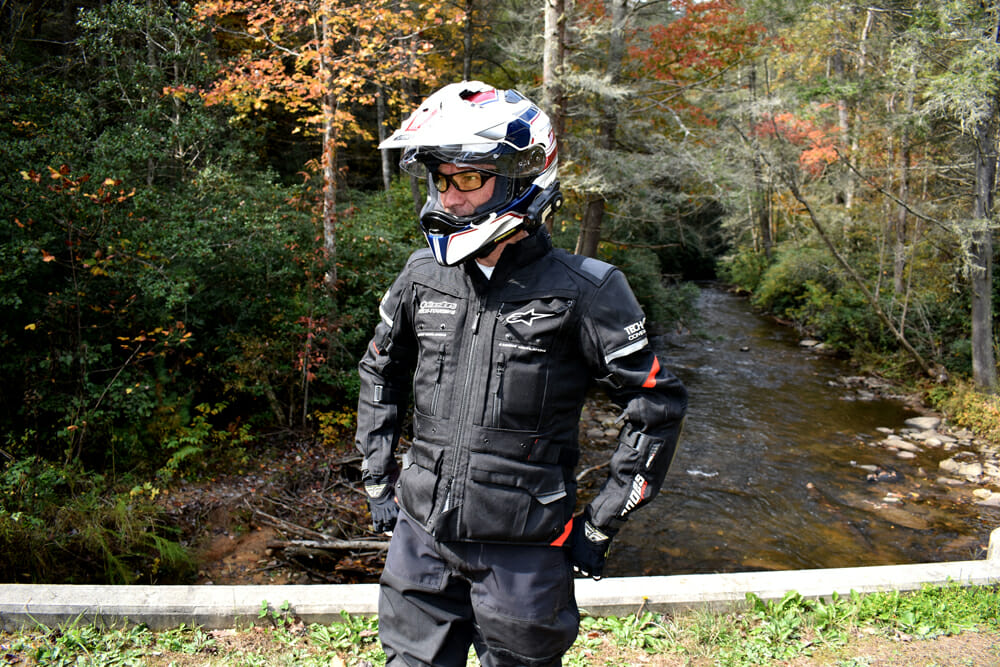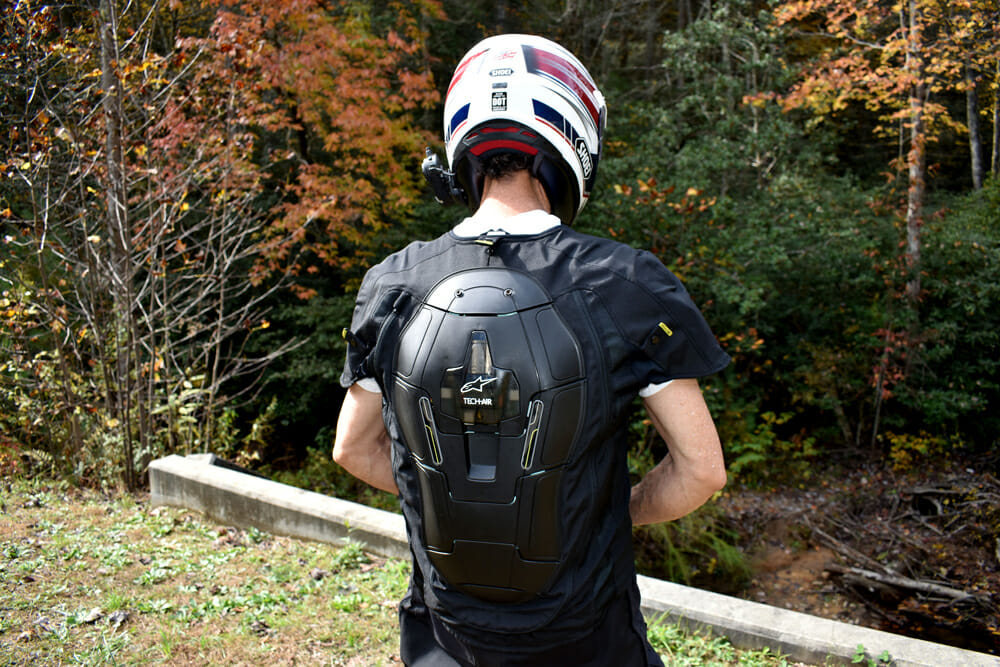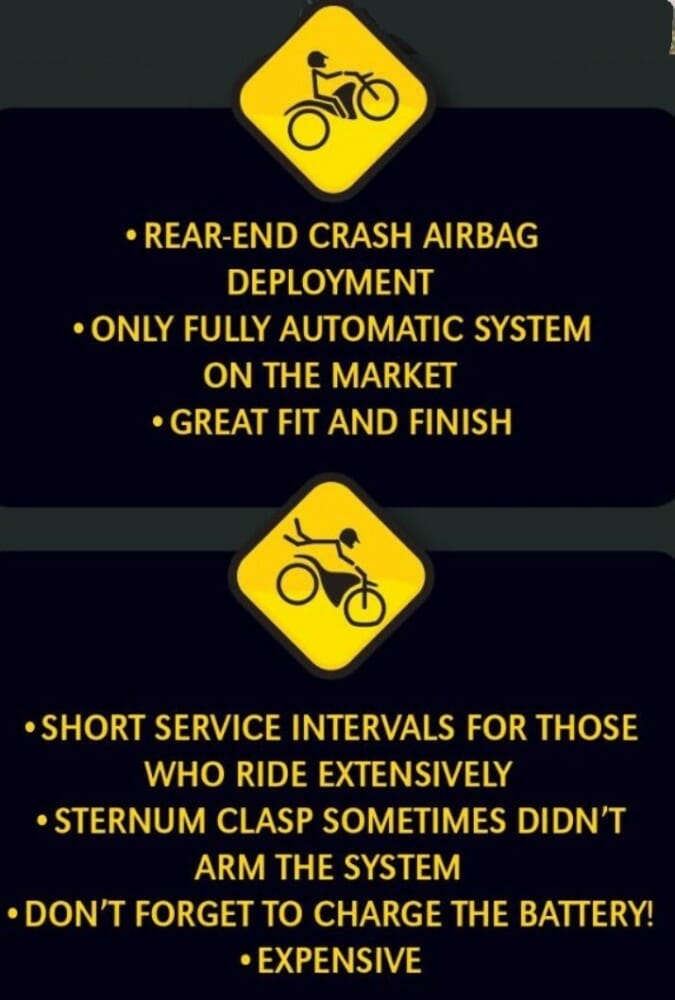Cycle News Staff | December 5, 2019
Always staying on the cutting edge of technology, Alpinestars’ research and development team worked countless hours to perfect the industry’s first personal airbag system for use in Grand Prix motorcycle racing, and they now offer a street version of this high-tech gear for everyday use by folks like you and me. In order to make the system work, two items need to be purchased: an Alpinestars Tech-Air-compatible outer garment (we chose the Andes Pro Jacket) and the Tech-Air System itself. According to Alpinestars, this combination is CE2 “compatible” and offers many advantages over traditional safety equipment, most notably, nearly instantaneous inflation in the event of an accident, even when the rider is stopped and is hit from the rear. No other equipment currently on the market can do that.
 We tested Alpinestar’s Tech-Air Street Airbag System with the Andes Pro Drystar Jacket. It’s a pricey package but could be, for some, well worth the piece of mind when it comes to safety.
We tested Alpinestar’s Tech-Air Street Airbag System with the Andes Pro Drystar Jacket. It’s a pricey package but could be, for some, well worth the piece of mind when it comes to safety.
Stand-Out Feature: Cutting-edge airbag technology
MSRP: Andes Pro Drystar Jacket $549.95, Tech-Air Street Airbag System $1149.95
Rider Analysis of Alpinestars Andes Pro Drystar Jacket and Tech-Air Airbag System:
If you’re like me, you probably watch Moto GP as much to see the unobtainium hardware as you do for the race itself, and while most of us will never have the opportunity to ride a MotoGP bike, thanks to Alpinestars, we can at least have MotoGP–level safety gear. Composed of gyros and sensors capable of detecting an accident and automatically deploying in less than 25 milliseconds, this system isn’t cheap. But when compared to other high-end gear, it’s not completely unreasonable, especially when you consider that this is the only system of its kind that can detect and deploy an “envelope of protection” in such a wide range of crash scenarios, even a rear-end collision when the rider is stopped and hit from behind—that’s if you’re wearing the Tech-Air Street. Alpinestars also offers a race version that has different deployment parameters specific to the race environment. Either system is available for sale, but the outer garment compatibility varies for each version. Once you’ve ponied up the cash for the version that best fits your needs, I think you’ll be pleased with the product, although there were some things that I found to be less than ideal.
 The Tech-Air Street Airbag System requires considerable upkeep and attention. But it could be well worth it in the long run.
The Tech-Air Street Airbag System requires considerable upkeep and attention. But it could be well worth it in the long run.
In typical Alpinestars fashion, the Andes Pro Drystar Jacket is beautiful, well-appointed gear with Italian style. Personally, I love the look and fit of this jacket, which is cut a little higher on the waist than typical adventure gear. The Tech-Air vest, which zips into the jacket, is then connected electronically with two electrical plugs. The system must be turned on before each ride and turned off when you’re not riding. It’s armed and made ready for use via a hook-and-loop clasp over the sternum on the jacket itself and must be positioned precisely in order to activate the system. A series of lights on the left sleeve indicates the status of the system and informs the rider if the jacket needs charging and whether or not it’s armed and ready. On more than one occasion during my two weeks of riding with this gear, I noticed, while riding, that the system was not activated due to the hook-and-loop clasp not being connected properly. The manual says that the system must complete a “stability check,” which can take up to 60 seconds before you ride, so perhaps I just needed to wait for that to happen. On each occasion I had just stopped for one thing or another and then resumed riding without rechecking the status of the Tech-Air System. I’m sure that as I use the gear more and more, I’ll learn to wait and make sure the system is ready before I take off.
Speaking of the manual, there are also printed warnings about who should and shouldn’t wear the Tech-Air, which includes people with heart conditions and people with “neck and back problems” as well as women who are pregnant. In reading the manual, I was surprised to learn that Alpinestars only recommends off-road riding with the Tech-Air in very limited conditions and on “gravel roads only.” Their definition of a gravel road is: an unpaved road surface with gravel, which is a minimum of 13 feet in width, and no gradients of +/- 30% and with no ruts, steps or holes greater than 19.5 inches in depth. I understand that much of this language is likely mandated by their legal department, but you should keep this in mind if you do a lot of off-road riding and you’re considering an investment in this system. You should also consider that Alpinestars recommends that this equipment be serviced by Alpinestars or an authorized service provider at least every two years. Again, that’s the minimum service interval. According to the manual, it could be as often as every six months for someone who rides “extensively.” Another thing to remember is that the Tech-Air System must be completely charged in order to work. A typical charge will last about 25 hours, according to Alpinestars, and it cannot be charged while in operation. If time is limited, a one-hour charge will give you approximately three to four hours of use.
Alpinestars should be applauded for their efforts to improve rider safety both on and off the race track. The Tech-Air System and the compatible Andes Pro Drystar Jacket, along with the other compatible Tech-Air garments, are beautifully constructed, very stylish riding gear that provide the wearer with the highest level of modern safety apparel, but you do have to pay close attention to charging, servicing, and making sure that the system is armed and ready every time you put the kickstand up. And, if you’re a hardcore adventure rider and you do a lot of off-road riding, make sure you read the fine print.

For more information, visit www.alpinestars.com